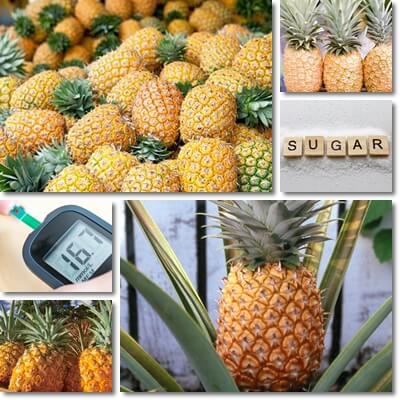Pineapple is one of the most popular fruits for diabetics and non-diabetics alike, gathering quite the following. For many, it is the embodiment of a healthy fruit, providing good nutrition and supplying varied benefits. But just how good is pineapple for you if you need to watch your blood sugar? What about the juice? And how much of the fruit/juice can you eat/drink with or without diabetes before it pushes blood sugar up to unhealthy levels? The glycemic effects of pineapple by intake or portion size are excellently illustrated by what is known as the ‘glycemic load’ scale.
What is the glycemic load?
The glycemic load (GL) is a scale that measures how the carbohydrates in a given serving of food affect blood sugar. More exactly, how fast the carbohydrates in a serving of a food are processed, meaning broken down into their simplest form, sugar, and how fast that sugar is absorbed into the bloodstream. Between 0 and 10 is a low GL. Between 11-19 is a moderate GL. Over 20 is a high GL. Now, the GL score of a food is calculated based on the glycemic index, a score/value assigned to a food estimating its effects on blood sugar, multiplied by the number of carbohydrates in a serving of a food (expressed in grams), then divided by 100.

- Glycemic index of pineapple and pineapple juice
The glycemic index (GI) goes from 0-100 and includes low GI foods (0-55), moderate GI foods (56-69) and high GI foods (70-100). The GI for pineapple is 66 (moderate score), meaning eating the fruit in moderation will not likely push blood sugar up high, but there will be a somewhat significant and noticeable rise. The GI of unsweetened pineapple juice is 46-56 (low to moderate); what this means is that drinking the unsweetened juice in modest amounts isn’t likely to affect blood sugar excessively, even with diabetes.
Glycemic load of pineapple per serving
The average glycemic load (GL) of pineapple is:
- 14 (per cup of pineapple)
- 9 (for 100 g serving of pineapple)
- 4 (for 50 g serving of pineapple)
Formula to determine glycemic load: glycemic index (GI) X carbohydrate content in grams / 100
- The glycemic load (GL) for a cup of fresh pineapple chunks (estimated weight: 165 g):
66 (glycemic index) X 21.65 (number of carbs in grams) / 100 = 14.28, estimated at 14 (moderate)
- The GL of fresh pineapple for 100 g serving:
66 X 13.12 / 100 = 8.65, estimated at 9 (low)
- The GL of fresh pineapple for 50 g serving:
66 X 6.56 / 100 = 4.3, estimated at 4 (low)
It’s important to note that not all pineapples have the exact same nutritional makeup and nutrition value determines glycemic effects. Some fruits will be naturally sweeter, other fruits more sour, depending on the variety. So carbohydrate content, sugar content included, is variable. Degree of ripeness also impacts nutritional value and glycemic impact. Unripe and less ripe fruits have more indigestible fiber and less digestible carbohydrates, so slightly less of an impact on blood sugar.
Riper fruits will have reached their nutritional potential and, consequently, become more readily digestible which will maximize their effects on blood sugar. And while differences are rather minimal (about 1-2 points on the GL scale, and up to 5-6 points on the GI scale), it goes to show that how much of a food you eat really does determine its effects on blood sugar.

How many carbs in pineapple?
- On average, pineapple has 13.12 g of carbohydrates per 100 g, 21.65 per cup (165 g) and 5.65 per 50 g.
- Less sweet varieties have 11.82 g of carbs per 100 g, 19.50 per cup (165 g) and 5.91 per 50 g.
- Sweeter varieties have 13.5 g of carbs per 100 g, 22.27 g per cup (165 g) and 6.75 g per 50 g of fruit.
Nutritional information courtesy of USDA.gov
Glycemic load of pineapple per variety
For less sweet pineapple varieties, the glycemic load will be:
- GL for 165 g cup of pineapple chunks: 66 (glycemic index) X 19.5 (carbs in grams)/100 = 12.87, estimated at 13 (moderate score)
- GL for 100 g serving: 66 X 11.82/100 = 7.8, estimated at 8 (low score)
- GL for 50 g serving: 66 X 5.91/100 = 3.9, estimated at 4 (low score)
For sweeter pineapple varieties, the glycemic load will be:
- GL for 165 g cup of pineapple chunks: 66 (glycemic index) X 22.27 (carbs in grams)/100 = 14.69, estimated at 15 (moderate score)
- GL for 100 g serving: 66 X 13.5/100 = 8.91, estimated at 9 (low score)
- GL for 50 g serving: 66 X 6.75/100 = 4.45, estimated at 4 (low score)
See also: Is Pineapple Acidic?
Glycemic load of pineapple juice
The glycemic load (GL) of pineapple juice: 13-18 (per cup, 240 ml of juice), 5-8 (per 100 ml)
The kind of fruit used to make pineapple juice, its ripeness, sweetness or other particularities will also have an impact of the resulting product and its glycemic effects. A cup (240 ml) of unsweetened pineapple juice has anywhere from 29 to 33 g of carbohydrates, whereas 100 ml provides 12.08 to 13.75 g of carbohydrates. The glycemic index of the unsweetened juice ranges from 46 to 56. Based on given carb content and GI values, here are the average GL values of the juice:
The glycemic load of unsweetened pineapple juice per glass of juice (240 ml) determined for the lowest GI score (46)
- 46 (glycemic index) X 29 (grams of carbs)/100 = 13.34, estimated at 13 (moderate score)
- 46 X 33/100 = 15.18, estimated at 15 (moderate score)
The glycemic load of unsweetened pineapple juice per glass of juice (240 ml) determined for the highest GI (56)
- 56 X 29/100 = 16.24, estimated at 16 (moderate score)
- 56 X 33/100 = 18.48, estimated at 18 (moderate score)
The glycemic load of unsweetened pineapple juice per 100 ml serving determined for the lowest GI (46)
- 46 (glycemic index) X 12.08 (grams of carbs)/100 = 5.55, estimated at 5 (low score)
- 46 X 13.75/100 = 6.32, estimated at 6 (low score)
The glycemic load of unsweetened pineapple juice per 100 ml serving determined for the for highest GI (56)
- 56 X 12.08/100 = 6.76, estimated at 7 (low score)
- 56 X 13.75/100 = 7.7, estimated at 8 (low score)
Pineapple and pineapple juice and diabetes
According to the glycemic load, even foods with a moderate to high glycemic index such as pineapple and pineapple juice can be consumed safely by diabetics and anyone needing to control their blood sugar.
The only condition is that intake be restricted to small amounts. The benefit of having small portions is you get limited amounts of carbohydrates from them which also limits effects on blood sugar, allowing you more control.
But it’s important to understand that foods can be wildly different from one another and, in the end, glycemic index and load values are simply estimates of their effects on blood sugar metabolism.
How you eat a food, whether it’s separate from other foods or paired with specific ones, further affects glycemic effects and so does the fact that different people may respond differently to the same food.
For example, it’s actually better for your blood sugar if you have a serving of pineapple fruit and have it after a meal or pair it with protein (nuts, seeds, chicken, cheese, eggs) than if you have it by itself, before a meal or worse, if you have the juice on an empty stomach.
Also, even though pineapple has a moderate glycemic index whereas the juice has a low glycemic index, making it better in theory than the whole fruit, the whole fruit is preferable because it has pulp and fiber which help with blood sugar control. Whereas the juice is too easy to overindulge in, is likely to have added sugars, not to mention a serving of juice is usually 240 ml, whereas a serving of fruit is somewhere along 100-112 g, meaning you are likely to benefit more from eating the whole fruit rather than drinking the juice.
